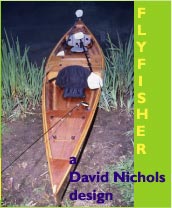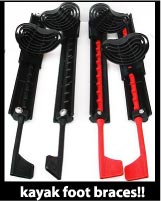
 Custom Search
|
| sails |
| plans |
| epoxy |
| rope/line |
| hardware |
| canoe/kayak |
| sailmaking |
| materials |
| models |
| media |
| tools |
| gear |
| join |
| home |
| indexes |
| classifieds |
| calendar |
| archives |
| about |
| links |
| Join Duckworks Get free newsletter CLICK HERE |
|
|
| The Everglades Challenge - 2013 |
by Gary Blankenship
- Talahassee, Florida - USA with comments in italics by Chuck Leinweber |
| Part 5: The Final Run part 1 - part 2 - part 3 - part 4 I had thought Chuck planned to get a meal and shower at Flamingo, and maybe a short nap before leaving sometime between 11 and noon, but I was wrong. After we got changed - for the first time I was able to dispense with fleece and long underwear - and Chuck fixed the oarlock mount, he was ready to be off. I made him wait while I grabbed a sandwich, milk and a couple snacks at the convenience store for the trip, and we left the dock at 10 a. m.
It's hard to convey the excitement we had at the approaching Florida Bay crossing. In my five previous EC finishes, twice strong easterly winds had compelled going around the bay, adding 20 miles or so to the 35 mile distance. Twice the crossing was in marginal wind directions that led to problems getting through some of the narrow channels and some wading in the notorious Florida Bay knee deep (if you're lucky) mud. Once was a late afternoon/night crossing with light following winds that died halfway across and led to some wonderful rowing in phosphorescent laden waters. But now we had moderate to strong following winds with the promise from the weather forecasters that they would remain that way all day. In 2009 EC, my wife, Helen, and I ran the Flamingo checkpoint, and there were no favorable winds all week, only winds from the easterly quadrant. And now we had a west wind. It looked like with a smooth crossing we might beat my best Florida Bay crossing time of around 12 hours (which, interestingly, was the one done with Chuck in 2006). We figured we might even make it by sundown, nine hours away. We came out of the boat basin and took a small gamble, bearing left instead of taking the marked channel. It was high tide and I had done this before, and we got away with it this time too, thanks to the Walkabout's shallow draft. A mere 20 minutes later, we entered Tin Can Channel, the GPS reading an exuberant 6.5 knots. We followed its undulations as the water changed from murky to the clarity for which the Bay is known. Chuck even talked me into shooting some underwater video with one of my cameras.
Since my GPS had the tracks and waypoints for the Bay, we settled into a division of labor where I kept lookout, shot videos, and fed courses to Chuck, who conned the boat though the passes and also kept a lookout. In just under an hour, we ran the 5 nautical mile length of Tin Can, and bore off to the ESE for Dump Key Channel. The wind was now blowing white streaks in the water, but because of the shallows, there were no significant waves. We scooted in the cut between the Dump Keys 30 minutes after leaving Tin Can, and set out for End Key, a turning point to reach Twisty Mile Channel. Instead of the wooden posts for the first two channels, Twisty, so named because it has lots of quick bends, was marked with short metal stakes. Or as Chuck observed, the green water was deep, the brown water was shallow. We had our only slight navigational error here cutting inside one of the stakes marking a turn. But we were allowed to go on with only a slight scraping of our partially lowered centerboard. We exited Twisty around 1:25 pm into slightly deeper waters that now turned the cloudy emerald color for which the Keys are famed. And I was dumbfounded by our speed. We were now more than halfway through the channels with only the shortest two remaining. Clearly we were having quite a run. But we didn't have too much time to reflect on this as the winds were increasing. So we paused while Chuck put a reef in the main and furled the mizzen, which did not affect our speed. (I recalled that we had to reef Oaracle in the same area in our 2006 passage.) We swapped positions, and I had the pleasure of steering Walkabout through Jimmie Channel and then over to Manatee Pass. Manatee is the only passage not approached head on. It felt a bit like jumping off a train to come screaming up to the cut and then turn 90 degrees (executing a gybe in these winds) to run it, but it went without a hitch, even if the channel looked shallow. We cleared the cut and then Manatee Key and turned east to head for the Atlantic Intracoastal Waterway, about 7 miles ahead.
Chuck left me at the helm and I kept having one thought as the seas, freed from nearby keys and given some slightly deeper water, began to build. That was: "We've had a good run in the EC and had a spectacular run across Florida Bay, and now I'm going to dump the boat just as we scent the finish line." But it didn't happen. Walkabout continued to handle the following seas without fuss. A wave would come boiling past the boat and then began to whitecap just in front of the bow. At the same time, the next mound of cloudy emerald would catch the boat just right and shove it forward through the breaking wave in front. Sometimes it took some helm correction to go straight, but sometimes the helm would go light and the tiller would seem to vibrate, and the boat would hum as it shot forward over the next wave or two before losing momentum and settling back, waiting for the next boost. Exhilarating is too puny a word to describe the ride. Here is a video with several clips from Florida Bay including one underwater shot! In 70 minutes, we were at the ICW, turning northeast just behind Dances With Mullet who had taken a slightly different route and hit the ICW further south. Chuck was steering now as we raced to the northeast, cleared Baker Cut into Buttonwood Sound and veered east for the finish line. The finish was marked on the GPS, but Chuck waited for definitive directions as I scanned the shoreline with my binoculars. But instead of directions, I started laughing. Four times I've been to this particular EC finish line - but every time had been at night. I didn't recognize anything in daylight. Oh, well. The GPS got us close and we watched Dances With Mullet, about five minutes ahead of us, to see where he went. We landed to a rousing welcome from other finishers.
I glanced at my watch: 3:47 pm. It was a perfect exclamation point for this year's EC. At four days, eight hours and 50 minutes, it was my second fastest finish and - at less than six hours! - it cut my previous best Florida Bay crossing time by more than half. Not bad for our combined wit. That night we crashed on the motel beds reserved for that day's finishers and listened to the wind howl. It was the first night where it didn't die. We were glad to be in. Here is a video montage with clips from the entire EC: |
|





